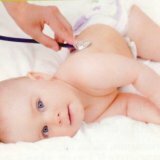Heart disease in newborns

Most often, heart disease in newborns occurs as a result of impaired development of the circulatory system during the fetal development stage. In its formation, a leading role is played by various adverse effects on the pregnant woman and the fetus on the terms from the third to the eighth week of pregnancy. It is at this time that the child's heart is formed.
Congenital heart diseases
Among the main reasons, it should be noted first of all the viral diseases suffered by a woman in the first trimester of pregnancy - rubella, influenza, respiratory infections, herpes, etc. Also important are the chronic illness of the mother, the use of various medications during pregnancy, chronic alcoholism of parents, regular smoking, and hereditary predisposition.
Symptoms of the disease - a marked lag in physical development, poor weight gain, frequent respiratory diseases. The main complaints are: rapid fatigue of the child, shortness of breath during exercise, and then at rest, pale skin. Cyanosis also always indicates a circulatory disorder that requires urgent medical intervention.
Congenital heart disease is different in nature. The most common are vices, in which there is an opening between the atria and ventricles in the heart partition. Because of this, part of the arterial blood comes from the left side of the heart to the right( venous) half or vice versa. At the same time, the blood circulation of the arterial blood is lower than in the norm. And arterial blood, in turn, enters the small circle of blood circulation, which causes its overload. The more in the small circle of blood circulation of the arterial blood, the more severe will be the defect.
Isolated pulmonary artery stenosis
The narrowing of the pulmonary arterial opening creates an obstacle to the flow of blood from the right ventricular cavity through the small circle of the circulation. With less severe stenosis, children develop normally for some time. The diagnosis of the same defect is, as a rule, with the occasional detection of changes in the child's heart - usually at the age of 6-12 years. The child with severe stenosis already at an early age complains of shortness of breath and pain in the heart. This vice always requires surgical intervention.
Aortic stenosis
In the presence of aortic stenosis, a serious obstacle is created for the flow of blood from the left ventricular cavity to the aorta. This happens due to deformation of valve flaps and narrowing of the main valve hole. Symptoms of a defect with a sharp stenosis can be observed in children already from an early age. This is shortness of breath, pale skin, tachycardia. Signs of severe stenosis are syncope arising during physical exertion. With such a defect, urgent surgical treatment is indicated.
Coarctation of the aorta
This is a narrowing of the aorta in any short section or a pronounced narrowing of the aorta over a long period. During the narrowing of the aorta, an obstacle is formed for the blood flow, there are two different circulatory regimes - just above and just below the narrowing site. In this case, the development of high blood pressure is higher than the site of narrowing, and lowered below the narrowing point. Children sometimes even develop hypertensive crises. Treatment of coarctation is carried out only in an operative way.
Arrhythmias
They are observed in children of any age. The occurrence of arrhythmia can be associated with functional disorders of the nervous system, and may appear against the background of inflammation of the heart muscles, heart disease and other diseases. They sometimes develop in healthy children under the influence on the body of various external factors - overload, heat, joy, fear, etc. To clarify the diagnosis you need to go through an electrocardiogram. Children with confirmed atrial fibrillation should receive lifelong treatment and are constantly observed at the cardiologist.
Myocarditis
is an inflammation of the heart muscle. It usually develops after the baby has been born after the birth of streptococcal infection. The disease begins acutely after 2-3 weeks after a severe angina. The first manifestations of the disease - heart palpitations, pain in the heart, shortness of breath. In the unfavorable course of the third week of the disease, endocarditis develops, an inflammation of the internal membranes of the heart. Treatment of the acute phase of the disease and preventive therapy to prevent new acute attacks of the disease is performed by a cardiothoracic doctor.



